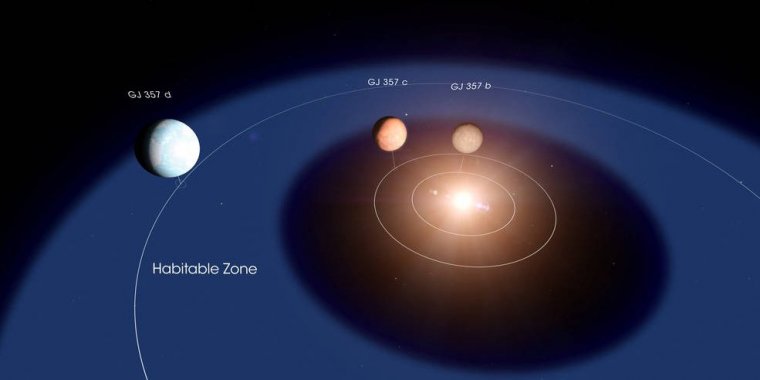| News / Space News |
Confirmation of Toasty TESS Planet Leads to Surprising Find of Promising World
A piping hot planet discovered by NASA’s Transiting Exoplanet Survey Satellite (TESS) has pointed the way to additional worlds orbiting the same star, one of which is located in the star’s habitable zone. If made of rock, this planet may be around twice Earth’s size.

This diagram shows the layout of the GJ 357 system. Planet d orbits within the star’s so-called habitable zone. Photo: NASA's Goddard Space Flight Center/Chris Smith
The new worlds orbit a star named GJ 357, an M-type dwarf about one-third the Sun’s mass and size and about 40% cooler that our star. The system is located 31 light-years away in the constellation Hydra. In February, TESS cameras caught the star dimming slightly every 3.9 days, revealing the presence of a transiting exoplanet — a world beyond our solar system — that passes across the face of its star during every orbit and briefly dims the star’s light.
The transits TESS observed belong to GJ 357 b, a planet about 22% larger than Earth. It orbits 11 times closer to its star than Mercury does our Sun. This gives it an equilibrium temperature — calculated without accounting for the additional warming effects of a possible atmosphere — of around 490 degrees Fahrenheit (254 degrees Celsius).
“We describe GJ 357 b as a ‘hot Earth,’” explains co-author Enric Pallé, an astrophysicist at the IAC.
But while researchers were looking at ground-based data to confirm the existence of the hot Earth, they uncovered two additional worlds. The farthest-known planet, named GJ 357 d, is especially intriguing.
GJ 357 d is located within the outer edge of its star’s habitable zone, where it receives about the same amount of stellar energy from its star as Mars does from the Sun. If the planet has a dense atmosphere, which will take future studies to determine, it could trap enough heat to warm the planet and allow liquid water on its surface.
Without an atmosphere, it has an equilibrium temperature of -64 F (-53 C), which would make the planet seem more glacial than habitable. The planet weighs at least 6.1 times Earth’s mass, and orbits the star every 55.7 days at a range about 20% of Earth’s distance from the Sun. The planet’s size and composition are unknown, but a rocky world with this mass would range from about one to two times Earth’s size.
GJ 357 c, the middle planet, has a mass at least 3.4 times Earth’s, orbits the star every 9.1 days at a distance a bit more than twice that of the transiting planet, and has an equilibrium temperature around 260 F (127 C).
TESS did not observe transits from this planet, which suggests its orbit is slightly tilted — perhaps by less than 1 degree — relative to the hot Earth’s orbit, so it never passes across the star from our perspective. (NASA)
YOU MAY ALSO LIKE


